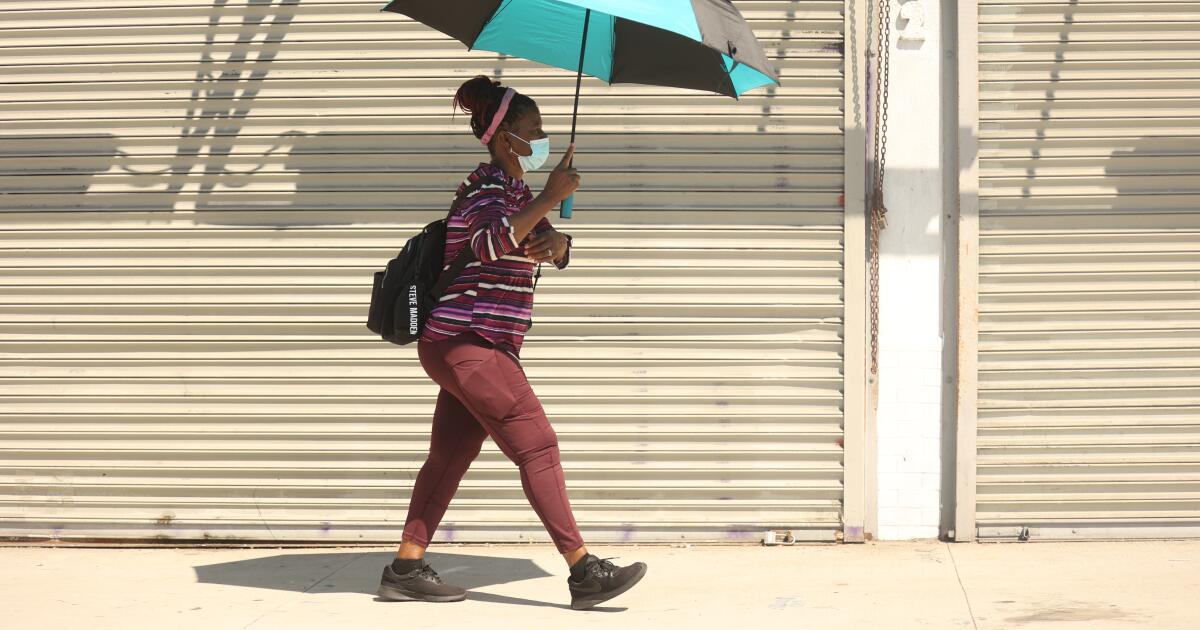

The worst of this week’s heat wave is heading toward Southern California over the next few days.
Forecast
Meteorologists predict temperatures could reach 43 to 46 degrees in the San Fernando Valley. Burbank, Woodland Hills, Pasadena, Santa Clarita and Palm Springs could also see triple-digit temperatures. Downtown Los Angeles is expected to see temperatures between 32 and 35 degrees.
Temperatures around 32 and 35 degrees are also expected in Long Beach, said Mike Wofford, a meteorologist with the National Weather Service in Oxnard. Inland Orange County is expected to stay around 32 degrees, and inland areas of San Diego County could reach as high as 38 degrees.
Triple-digit temperatures are expected elsewhere in the Southland. It could reach 106 degrees in Santa Clarita and 118 degrees in Palm Springs by Thursday. And temperatures in the Inland Empire could reach 112 degrees.
Warnings
The weather service issued an excessive heat warning from 11 a.m. Wednesday to 8 p.m. Friday for most of Los Angeles County, warning the public of high temperatures reaching 95 to 110 degrees.
Nighttime temperatures between 21 and 29 degrees are unlikely to provide much relief from the heat.
Chronology
Wednesday: 94 in downtown Los Angeles; 80 in Santa Barbara; 110 in Woodland Hills
THURSDAY: 97 in downtown Los Angeles; 82 in Santa Barbara; 113 in Woodland Hills
Friday: 95 in downtown Los Angeles; 82 in Santa Barbara; 111 in Woodland Hills
SATURDAY: 93 in downtown Los Angeles; 80 in Santa Barbara; 108 in Woodland Hills
Fire hazard
Authorities are also warning of an increased risk of fire due to the sweltering heat.
There is one bright spot, however: Santa Ana winds will not accompany extreme temperatures, reducing the risk of fast-moving, wind-driven wildfires.
Security
Los Angeles Mayor Karen Bass announced this week that hundreds of cooling centers will be open through Friday across Los Angeles, including “climate stations” on Skid Row where people will have access to shade, seating and cold drinks.
Residents can find a list of cooling centers and “climate stations” online.
Stay hydrated
Drinking more water than usual and doing so before you feel thirsty will help you stay hydrated. If you are outdoors and sweating, the norm is to drink two to four cups of water, or about 500 to 1,000 ml, every hour.
Dr. Fausto Farfan, chief of emergency services at Kaiser Permanente Woodland Hills Medical Center, also suggested adding electrolytes to water or drinking sports drinks to help your body replenish the salt and minerals you lose through sweating.
One way to know if you are adequately hydrated is to pay attention to your urine. If it is dark yellow or brownish, it is a sign that you need to drink more fluids.
“As a general rule, if you’re staying well hydrated, your urine should be a light yellow color,” Farfan said. And if you’re urinating less than usual, it’s probably time to drink more.
According to the U.S. Centers for Disease Control and Prevention, heat-related illnesses can range from sunburn and heat rash to more dangerous conditions such as heat exhaustion and sunstroke.
Signs of heatstroke, the most serious of all heat-related illnesses, include a body temperature of 103 degrees or higher, a rapid and pounding pulse, hot, flushed, dry or moist skin, headache, dizziness, nausea, confusion and fainting. If you or someone you know has these symptoms, seek medical attention immediately. In the meantime, the CDC recommends moving to a cooler area and lowering your body temperature with cool towels or a cool bath, but don’t drink anything.
According to the CDC, signs of heat exhaustion include profuse sweating, cool, pale, clammy skin, rapid and weak pulse, nausea or vomiting, muscle cramps, fatigue or weakness, dizziness, headache, and fainting. If you have these symptoms, move to a cool place, loosen your clothing, put on cool, damp clothing, or take a cool shower and drink water.
Seek immediate medical attention if you vomit, if your symptoms worsen, or if they last more than 1 hour.
Protecting the most vulnerable
Children, pets, the elderly, the homeless, pregnant women and people with chronic illnesses are more vulnerable to heat-related illnesses.
Farfan said they will need the same protective measures as everyone else, but it is important to monitor them, “a sort of buddy system to keep an eye on them in case they don’t realize they are starting to overheat.”
If you notice they are red, sweating excessively, having more difficulty moving, or showing other symptoms of heat-related illness, give them water and help them move to a cooler area.
And never leave a child or pet in a car. Temperatures can soar, even with the windows open.
Stay informed
Los Angeles residents can sign up for extreme heat alerts on the city’s website . You can also check the forecast for your area on the National Weather Service website , and find weather alerts, warnings and advisories for California and beyond on the National Oceanic and Atmospheric Administration website .
Other tips for staying cool
- Eat foods with high water content, such as watermelon and cucumbers, but limit or avoid sugary, alcoholic and caffeinated drinks.
- Wear loose, light-colored clothing and hats for protection.
- If possible, keep your pets indoors. If you must keep them outside, make sure they have plenty of shade and water.
- Take a cold shower.
- If possible, avoid using your stove, oven or other appliances that generate heat.


